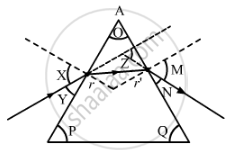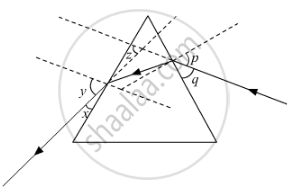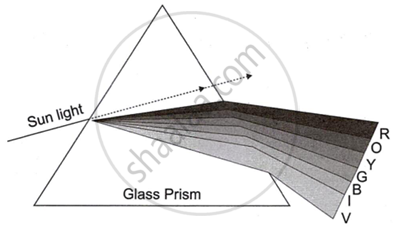Advertisements
Advertisements
Question
What will happen if another similar glass prism is placed upside down behind the first prism?
Solution
If a second, similar glass prism is placed upside down behind the first prism, recombination of seven colours takes place and a patch of ordinary white light is obtained on a screen placed behind the second prism. The recombination of colours took place because the second prism was placed upside down, because of which the refraction produced by the second prism was equal and opposite to the refraction produced by the first prism.
APPEARS IN
RELATED QUESTIONS
A student traces the path of a ray of light through a triangular glass prism for different values of angle of incidence. On analyzing the ray diagrams, which one of the following conclusions is he likely to draw?
(A) The emergent ray is parallel to the incident ray.
(B) The emergent ray bends at an angle to the direction of the incident ray.
(C) The emergent ray and the refracted ray are at right angles to each other.
(D) The emergent ray is perpendicular to the incident ray.
Describe an activity to show that colours of white light splitted by a glass prism can be recombined to get white light by another identical glass prism. Also draw ray diagram to show the recombination of the spectrum of white light.
The path of a ray of light passing through a glass prism is shown below:

In this diagram, the angle of prism, angle of incidence, angle of emergence and angle of deviation, respectively, have been represented by:
(A) O, Y, Z and N,
(B) P, Y, M and Z,
(C) O, X, M and Z,
(D) P, X, Z and N.
Study the following ray diagram:

In this diagram, the angle of incidence, the angle of emergence and the angle of deviation respectively have been represented by
(A) y, p, z
(B) x, q, z
(C) p, y, z
(D) p, z, y
Draw a ray diagram to show the dispersion of white light.
Observe the given figure and write appropriate phenomenon of light in the box.

The sunlight can be split into its constituent colors using ______.
Name the scientist who was the first to use a glass prism to obtain the spectrum of sunlight.
The angle of deviation through a prism is minimum when

- Incident rays and emergent rays are symmetric to the prism.
- The refracted ray inside the prism becomes parallel to its base.
- The angle of incidence is equal to that of the angle of emergence.
- When the angle of emergence has doubled the angle of incidence.
Choose the correct answer from the options given below:
Observe the given diagram and answer the questions:

- Name the process shown in the figure.
- Name the colour that deviates the most.
- Name the colour that deviates the least.
- Name any one phenomenon in nature which is based on the above process.
- Define ‘spectrum’.
